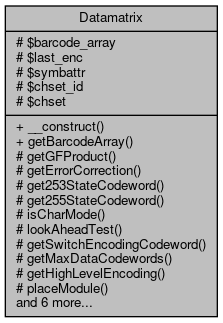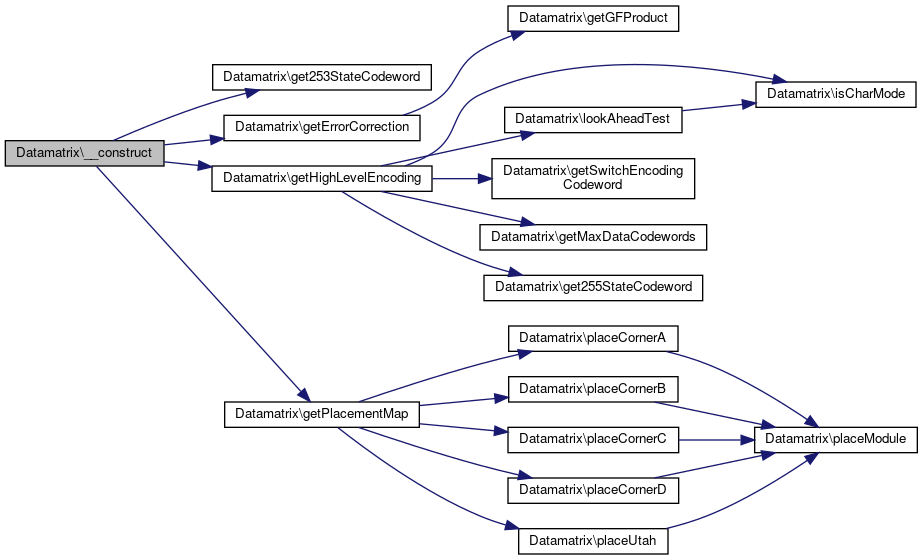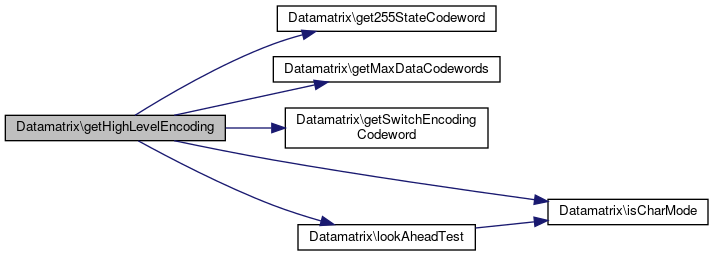Class to create DataMatrix ECC 200 barcode arrays for TCPDF class. More...
 Collaboration diagram for Datamatrix:
Collaboration diagram for Datamatrix:Public Member Functions | |
| __construct ($code) | |
| This is the class constructor. More... | |
| getBarcodeArray () | |
| Returns a barcode array which is readable by TCPDF. More... | |
Protected Member Functions | |
| getGFProduct ($a, $b, $log, $alog, $gf) | |
| Product of two numbers in a Power-of-Two Galois Field. More... | |
| getErrorCorrection ($wd, $nb, $nd, $nc, $gf=256, $pp=301) | |
| Add error correction codewords to data codewords array (ANNEX E). More... | |
| get253StateCodeword ($cwpad, $cwpos) | |
| Return the 253-state codeword. More... | |
| get255StateCodeword ($cwpad, $cwpos) | |
| Return the 255-state codeword. More... | |
| isCharMode ($chr, $mode) | |
| Returns true if the char belongs to the selected mode. More... | |
| lookAheadTest ($data, $pos, $mode) | |
| The look-ahead test scans the data to be encoded to find the best mode (Annex P - steps from J to S). More... | |
| getSwitchEncodingCodeword ($mode) | |
| Get the switching codeword to a new encoding mode (latch codeword) More... | |
| getMaxDataCodewords ($numcw) | |
| Choose the minimum matrix size and return the max number of data codewords. More... | |
| getHighLevelEncoding ($data) | |
| Get high level encoding using the minimum symbol data characters for ECC 200. More... | |
| placeModule ($marr, $nrow, $ncol, $row, $col, $chr, $bit) | |
| Places "chr+bit" with appropriate wrapping within array[]. More... | |
| placeUtah ($marr, $nrow, $ncol, $row, $col, $chr) | |
| Places the 8 bits of a utah-shaped symbol character. More... | |
| placeCornerA ($marr, $nrow, $ncol, $chr) | |
| Places the 8 bits of the first special corner case. More... | |
| placeCornerB ($marr, $nrow, $ncol, $chr) | |
| Places the 8 bits of the second special corner case. More... | |
| placeCornerC ($marr, $nrow, $ncol, $chr) | |
| Places the 8 bits of the third special corner case. More... | |
| placeCornerD ($marr, $nrow, $ncol, $chr) | |
| Places the 8 bits of the fourth special corner case. More... | |
| getPlacementMap ($nrow, $ncol) | |
| Build a placement map. More... | |
Protected Attributes | |
| $barcode_array = array() | |
| Barcode array to be returned which is readable by TCPDF. More... | |
| $last_enc = ENC_ASCII | |
| Store last used encoding for data codewords. More... | |
| $symbattr | |
| Table of Data Matrix ECC 200 Symbol Attributes: More... | |
| $chset_id = array(ENC_C40 => 'C40', ENC_TXT => 'TXT', ENC_X12 =>'X12') | |
| Map encodation modes whit character sets. More... | |
| $chset | |
| Basic set of characters for each encodation mode. More... | |
Detailed Description
Class to create DataMatrix ECC 200 barcode arrays for TCPDF class.
DataMatrix (ISO/IEC 16022:2006) is a 2-dimensional bar code.
Definition at line 110 of file datamatrix.php.
Constructor & Destructor Documentation
◆ __construct()
| Datamatrix::__construct | ( | $code | ) |
This is the class constructor.
Creates a datamatrix object
- Parameters
-
$code (string) Code to represent using Datamatrix.
Definition at line 235 of file datamatrix.php.
References $barcode_array, $code, $nd, $params, $r, $row, ENC_ASCII, ENC_BASE256, ENC_EDF, get253StateCodeword(), getErrorCorrection(), getHighLevelEncoding(), and getPlacementMap().
 Here is the call graph for this function:
Here is the call graph for this function:Member Function Documentation
◆ get253StateCodeword()
|
protected |
Return the 253-state codeword.
- Parameters
-
$cwpad (int) Pad codeword. $cwpos (int) Number of data codewords from the beginning of encoded data.
- Returns
- pad codeword
Definition at line 446 of file datamatrix.php.
Referenced by __construct().
 Here is the caller graph for this function:
Here is the caller graph for this function:◆ get255StateCodeword()
|
protected |
Return the 255-state codeword.
- Parameters
-
$cwpad (int) Pad codeword. $cwpos (int) Number of data codewords from the beginning of encoded data.
- Returns
- pad codeword
Definition at line 461 of file datamatrix.php.
Referenced by getHighLevelEncoding().
 Here is the caller graph for this function:
Here is the caller graph for this function:◆ getBarcodeArray()
| Datamatrix::getBarcodeArray | ( | ) |
Returns a barcode array which is readable by TCPDF.
- Returns
- array barcode array readable by TCPDF;
Definition at line 352 of file datamatrix.php.
References $barcode_array.
◆ getErrorCorrection()
|
protected |
Add error correction codewords to data codewords array (ANNEX E).
- Parameters
-
$wd (array) Array of datacodewords. $nb (int) Number of blocks. $nd (int) Number of data codewords per block. $nc (int) Number of correction codewords per block. $gf (int) numner of fields on log/antilog table (power of 2). $pp (int) The value of its prime modulus polynomial (301 for ECC200).
- Returns
- array data codewords + error codewords
Definition at line 384 of file datamatrix.php.
References $log, $n, $nd, and getGFProduct().
Referenced by __construct().
 Here is the call graph for this function:
Here is the call graph for this function: Here is the caller graph for this function:
Here is the caller graph for this function:◆ getGFProduct()
|
protected |
Product of two numbers in a Power-of-Two Galois Field.
- Parameters
-
$a (int) first number to multiply. $b (int) second number to multiply. $log (array) Log table. $alog (array) Anti-Log table. $gf (array) Number of Factors of the Reed-Solomon polynomial.
- Returns
- int product
Definition at line 366 of file datamatrix.php.
References $log.
Referenced by getErrorCorrection().
 Here is the caller graph for this function:
Here is the caller graph for this function:◆ getHighLevelEncoding()
|
protected |
Get high level encoding using the minimum symbol data characters for ECC 200.
- Parameters
-
$data (string) data to encode
- Returns
- array of codewords
Definition at line 707 of file datamatrix.php.
References $data, ENC_ASCII, ENC_ASCII_EXT, ENC_ASCII_NUM, ENC_BASE256, ENC_C40, ENC_EDF, ENC_TXT, ENC_X12, get255StateCodeword(), getMaxDataCodewords(), getSwitchEncodingCodeword(), isCharMode(), and lookAheadTest().
Referenced by __construct().
 Here is the call graph for this function:
Here is the call graph for this function: Here is the caller graph for this function:
Here is the caller graph for this function:◆ getMaxDataCodewords()
|
protected |
Choose the minimum matrix size and return the max number of data codewords.
- Parameters
-
$numcw (int) Number of current codewords.
- Returns
- number of data codewords in matrix
Definition at line 692 of file datamatrix.php.
Referenced by getHighLevelEncoding().
 Here is the caller graph for this function:
Here is the caller graph for this function:◆ getPlacementMap()
|
protected |
Build a placement map.
(Annex F - ECC 200 symbol character placement)
- Parameters
-
$nrow (int) Number of rows. $ncol (int) Number of columns.
- Returns
- array
Definition at line 1116 of file datamatrix.php.
References $row, placeCornerA(), placeCornerB(), placeCornerC(), placeCornerD(), and placeUtah().
Referenced by __construct().
 Here is the call graph for this function:
Here is the call graph for this function: Here is the caller graph for this function:
Here is the caller graph for this function:◆ getSwitchEncodingCodeword()
|
protected |
Get the switching codeword to a new encoding mode (latch codeword)
- Parameters
-
$mode (int) New encoding mode.
- Returns
- (int) Switch codeword.
Definition at line 653 of file datamatrix.php.
References ENC_ASCII, ENC_BASE256, ENC_C40, ENC_EDF, ENC_TXT, and ENC_X12.
Referenced by getHighLevelEncoding().
 Here is the caller graph for this function:
Here is the caller graph for this function:◆ isCharMode()
|
protected |
Returns true if the char belongs to the selected mode.
- Parameters
-
$chr (int) Character (byte) to check. $mode (int) Current encoding mode.
- Returns
- boolean true if the char is of the selected mode.
Definition at line 476 of file datamatrix.php.
References ENC_ASCII, ENC_ASCII_EXT, ENC_ASCII_NUM, ENC_BASE256, ENC_C40, ENC_EDF, ENC_TXT, and ENC_X12.
Referenced by getHighLevelEncoding(), and lookAheadTest().
 Here is the caller graph for this function:
Here is the caller graph for this function:◆ lookAheadTest()
|
protected |
The look-ahead test scans the data to be encoded to find the best mode (Annex P - steps from J to S).
- Parameters
-
$data (string) data to encode $pos (int) current position $mode (int) current encoding mode
- Returns
- int encoding mode
Definition at line 523 of file datamatrix.php.
References $data, ENC_ASCII, ENC_ASCII_EXT, ENC_ASCII_NUM, ENC_BASE256, ENC_C40, ENC_EDF, ENC_TXT, ENC_X12, and isCharMode().
Referenced by getHighLevelEncoding().
 Here is the call graph for this function:
Here is the call graph for this function: Here is the caller graph for this function:
Here is the caller graph for this function:◆ placeCornerA()
|
protected |
Places the 8 bits of the first special corner case.
(Annex F - ECC 200 symbol character placement)
- Parameters
-
$marr (array) Array of symbols. $nrow (int) Number of rows. $ncol (int) Number of columns. $chr (int) Char byte.
- Returns
- array
Definition at line 1030 of file datamatrix.php.
References placeModule().
Referenced by getPlacementMap().
 Here is the call graph for this function:
Here is the call graph for this function: Here is the caller graph for this function:
Here is the caller graph for this function:◆ placeCornerB()
|
protected |
Places the 8 bits of the second special corner case.
(Annex F - ECC 200 symbol character placement)
- Parameters
-
$marr (array) Array of symbols. $nrow (int) Number of rows. $ncol (int) Number of columns. $chr (int) Char byte.
- Returns
- array
Definition at line 1052 of file datamatrix.php.
References placeModule().
Referenced by getPlacementMap().
 Here is the call graph for this function:
Here is the call graph for this function: Here is the caller graph for this function:
Here is the caller graph for this function:◆ placeCornerC()
|
protected |
Places the 8 bits of the third special corner case.
(Annex F - ECC 200 symbol character placement)
- Parameters
-
$marr (array) Array of symbols. $nrow (int) Number of rows. $ncol (int) Number of columns. $chr (int) Char byte.
- Returns
- array
Definition at line 1074 of file datamatrix.php.
References placeModule().
Referenced by getPlacementMap().
 Here is the call graph for this function:
Here is the call graph for this function: Here is the caller graph for this function:
Here is the caller graph for this function:◆ placeCornerD()
|
protected |
Places the 8 bits of the fourth special corner case.
(Annex F - ECC 200 symbol character placement)
- Parameters
-
$marr (array) Array of symbols. $nrow (int) Number of rows. $ncol (int) Number of columns. $chr (int) Char byte.
- Returns
- array
Definition at line 1096 of file datamatrix.php.
References placeModule().
Referenced by getPlacementMap().
 Here is the call graph for this function:
Here is the call graph for this function: Here is the caller graph for this function:
Here is the caller graph for this function:◆ placeModule()
|
protected |
Places "chr+bit" with appropriate wrapping within array[].
(Annex F - ECC 200 symbol character placement)
- Parameters
-
$marr (array) Array of symbols. $nrow (int) Number of rows. $ncol (int) Number of columns. $row (int) Row number. $col (int) Column number. $chr (int) Char byte. $bit (int) Bit.
- Returns
- array
Definition at line 983 of file datamatrix.php.
References $row.
Referenced by placeCornerA(), placeCornerB(), placeCornerC(), placeCornerD(), and placeUtah().
 Here is the caller graph for this function:
Here is the caller graph for this function:◆ placeUtah()
|
protected |
Places the 8 bits of a utah-shaped symbol character.
(Annex F - ECC 200 symbol character placement)
- Parameters
-
$marr (array) Array of symbols. $nrow (int) Number of rows. $ncol (int) Number of columns. $row (int) Row number. $col (int) Column number. $chr (int) Char byte.
- Returns
- array
Definition at line 1008 of file datamatrix.php.
References $row, and placeModule().
Referenced by getPlacementMap().
 Here is the call graph for this function:
Here is the call graph for this function: Here is the caller graph for this function:
Here is the caller graph for this function:Field Documentation
◆ $barcode_array
|
protected |
Barcode array to be returned which is readable by TCPDF.
Definition at line 116 of file datamatrix.php.
Referenced by __construct(), and getBarcodeArray().
◆ $chset
|
protected |
Basic set of characters for each encodation mode.
Definition at line 190 of file datamatrix.php.
◆ $chset_id
Map encodation modes whit character sets.
Definition at line 184 of file datamatrix.php.
◆ $last_enc
|
protected |
Store last used encoding for data codewords.
Definition at line 122 of file datamatrix.php.
◆ $symbattr
|
protected |
Table of Data Matrix ECC 200 Symbol Attributes:
- total matrix rows (including finder pattern)
- total matrix cols (including finder pattern)
- total matrix rows (without finder pattern)
- total matrix cols (without finder pattern)
- region data rows (with finder pattern)
- region data col (with finder pattern)
- region data rows (without finder pattern)
- region data col (without finder pattern)
- horizontal regions
- vertical regions
- regions
- data codewords
- error codewords
- blocks
- data codewords per block
- error codewords per block
Definition at line 145 of file datamatrix.php.
The documentation for this class was generated from the following file:
- Services/PDFGeneration/classes/tcpdf/include/barcodes/datamatrix.php



























